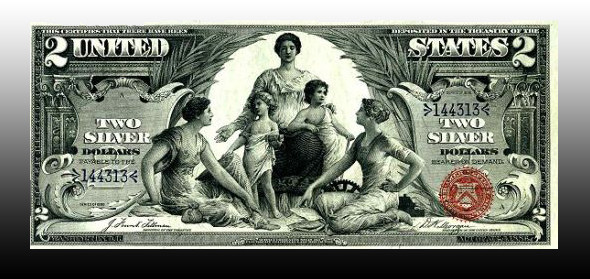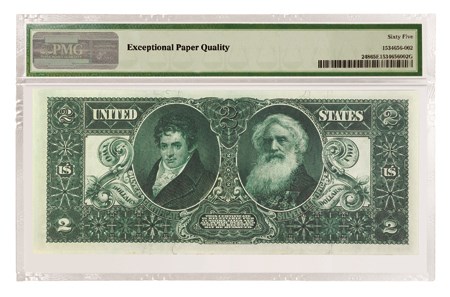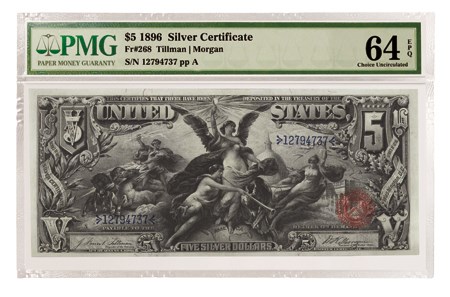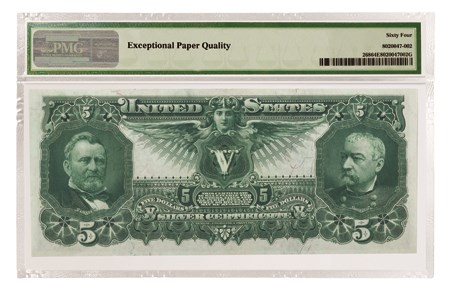
By Jay H. Recher – Paper Money Guaranty Corporation ……
Welcome back to the conclusion on who engraved the Educational Series. The previous article discussed the $1 (Fr. 224-225), while this article will talk about the $2 (Fr. 248-249) and the $5 (Fr. 268-270). Just like part one, part two will give a little history on who made these beautiful notes.
Will H. Low, the designer of the $1 also attempted to design the $2 as well. See the scan below for Low’s proposed $2 which was called “War and Defence”. Although he had to overcome a few obstacles – namely, that of Bureau Chief Johnson’s numerous demands. Some of those demands include: removing a flag that the male figure (Defence) was holding; his chin was too pronounced; and the bench needed to be extended. Low did not like nor understand why these changes were needed as two engravers (Charles Schlecht and G.F.C. Smillie) were already on board with his design. On January 5, 1895 Low received bad news.
Johnson wrote this to Low:
“The design has been before me since its receipt and, after considering it from every point of view, I am forced to the painful duty of saying that it is not satisfactory. I do not feel that it is necessary for me to go into details as to the several features of the design, which are unacceptable.”[1]

Scan of Will H. Low’s Proposed $2 Note
The question Bureau Chief Johnson needed to answer was who was going to design for the upcoming $2 note? He found his answer in Edwin H. Blashfield. There was one problem. Blashfield did not have a design for the $2; his design was for a $50. Much like Low, Blashfield did not approve of Johnson’s changes. Blashfield stated, in a letter to Johnson, that he would be fine with it as a $10 or a $20 anything besides a single digit number. He went on saying that he structured the design of “Science presenting steam and electricity to Commerce and Manufacture” in a pyramid and a two could not hold the same compositional effect as a 50 can. Needless to say, Johnson won this argument and Blashfield made the required changes in order to appease his boss.

$2 1896 Silver Certificate, Obverse
Lorenzo Hatch engraved both the portraits of Robert Fulton (inventor of commercial steamboat) and Samuel F.B. Morse (the inventor of the telegraph). These portraits are the focal points on the back of the note, and create a perfect circle with the allegory on the front. As with the $1, Thomas F. Morris was the rear back designer as well as the central frame and background designer on the front of the note.

$2 1896 Silver Certificate, Reverse
That leaves us with the $5 silver certificate “Electricity as the Dominant Force in the World” designed by Walter Shirlaw, an engraver, painter and muralist. At the center of this gorgeous note is winged female (Electricity) holding a light bulb. To her right is Jupiter riding in on a chariot while holding a lightning bolt that is energizing the light bulb. Next is Fame with a trumpet delivering sweet music over a map of the United States. To her right is a bald eagle standing guard of America and Washington D.C. (which can be seen in the background). Finally, to Electricity’s far right is Peace along with her dove – always the symbol of peace.
Thomas F. Morris persuaded Johnson to change the scrollwork around the border of the note, and is credited for changing these elements. Shirlaw originally had blank shields at the left and right borders. Morris added the plant life surrounding the phrases seen at the left and right hand side. G.F.C. Smillie engraved the front of the $5 note.[2]

$5 1896 Silver Certificate, Obverse
Morris, Smillie and Hatch again worked together to design and engrave the back of this last note in the Educational series. Morris and Hatch took over the duties to design the whole of the note while Smillie was the primary engraver. The female head at the top center is rumored to greatly resemble the wife of Morris. It was Hatch’s job to engrave, yet again, the portraits that are seen: General Ulysses S. Grant at left, and General Philip Sheridan at right. Both generals were active during the Civil War and had several ties to one another. Including Grant and Sheridan there are only two other Commanding Generals to appear on a U.S. banknote.

$5 1896 Silver Certificate, Reverse
As with the $1 before it, there was some public criticism of these notes. Most obviously was the bare chested Electricity. Several groups wrote letters to Johnson urging him to clothe her in future versions of the note. Bank tellers also complained saying that it was hard to count at a fast pace – due to the denominations not being at the top corners. Another issue was after much handling the notes became smeared and hard to read and the notes also look fake. These complaints were fixed by making the numbers clearer and adding lathe work to the corners.[3]
At one point there were plans to design and make higher denominations ($10, $20, etc) but there was a changing of the guard. In 1897 a new Secretary was placed into office – Lyman J. Gage. Gage was not a fan of the Educational Series and went on record numerous times saying that all future notes will not be designed by painters and that they will be practically identical, simple, clear and straightforward in all of their designs. This was the end of powerful panoramic views on banknotes.
This short lived series may have only been in circulation for a few years, but it certainly has not left our hearts and our minds as some of the most artistic designs ever to grace a U.S. banknote.
* * *
Notes
[1] Hessler, Gene. U.S. Essay, Proof, and Specimen Notes (Port Clinton, Ohio: BNR, 2004), 100.
[2] Friedberg, Arthur L., Friedberg, Ira S., and Friedberg, Robert. Paper Money of the United States: A Complete Guide with Valuations: The Standard Reference Work on Paper Money. N.p.:n.p., n.d., 80.
[3] “Five Dollars: The Paper Currency Of 1896.” Five Dollars: The Paper Currency Of 1896. N.p., n.d. http://flyingmoose.org/truthfic/1896.htm
Originally posted on www.pmgnotes.com
* * *




